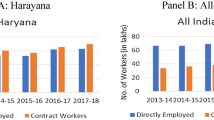Abstract
This paper investigates the importance of various types of human capital and highlights the role played by industry tenure in determining wages in Taiwan. It also aims to offer possible explanations as to why industry-specific human capital is much less significant than it is in the United States. Empirically, it is found that, other things being equal, accumulating industry tenure decreases earnings for both the least-skilled workers and those employed in mid-sized firms. Industry-specific skills are not yet deeply implemented in most occupations and firms of all sizes. This might also account for the remarkable level of labor reallocation among industries that is observed in Taiwan. Furthermore, the capital stock accumulated through education is found to be the most crucial in determining wages in all estimations and a factor considered the engine of growth during the miraculous development of Taiwan's economy. However, the importance of other types of human capital on earnings – namely, general labor market experience and firm-specific human capital, varies substantially across groups.
Similar content being viewed by others
References
Abraham, K. G. and H. S. Farber, 1987, 'Job Duration, Seniority and Earnings', American Economic Review 77(3), 278-297.
Addison, J. and P. Portugal, 1989, 'Job Displacement, Relative Wage Changes, and Duration of Unemployment', Journal of Labor Economics 7(3), 281-302.
Altonji, J. and R. Shakotko, 1987, 'Do Wages Rise with Job Seniority?' Review of Economic Studies 54(4), 437-459.
Carrington, W., 1993, 'Wage Loss for Displaced Workers: Is It Really the Firms That Matter?' Journal of Human Resources 28(3), 435-462.
Carrington, W. and A. Zaman, 1994, 'Interindustry Variation in the Costs of Job Displacement', Journal of Labor Economics 12(2), 243-276.
Chung, Y. C. and P. F. Hsu, 1999, 'An Empirical Study on Wage Differentials and Firm Size in Taiwan', Taiwan Economic Review 27(2), 241-267 (in Chinese, with English abstract).
Doi, N and M. Cowling, 1998, 'The Evolution of Firm Size and Employment Share Distribution in Japanese and U.K.Manufacturing: A Study of Small Business Presence', Small Business Economics 10(4), 283-292.
Ehrenberg, R. and R. Smith, 2000, Modern Labor Economics, Theory and Public Policy, Addison Wesley Longman, Inc.
Fallick, B., 1993, 'The Industrial Mobility of Displaced Workers', Journal of Labor Economics 11(2), 302-323.
Huang, F. M., 1997, 'Population and Asia's Economic Miracle: Education and Earning in Taiwan', Paper presented at the Population and the Asia Economic Miracle Honolulu Conference.
Irwin, D. and P. Llenow, 1996, 'High-Tech R&D Subsidies: Esitmating the Effects of Sematch', Journal of International Economics 40, 323-344.
Jiang, F. F., 1988, 'A Study on the Sex-Wage Differentials of Junior High in Taiwan: A Human Capital Approach', Taiwan Economic Review 16(3), 323-347 (in Chinese, with English abstract).
Kletzer, L. G., 1989, 'Returns to Seniority after Permanent Job Loss', American Economic Review 79(3), 536-543.
Levy, D. and Terleckyi, N., 1983, 'Effects of Government R&D on Private R&D Investment and Productivity: A Macroeconomic Analysis', Bell Journal of Economics 14, 551-561.
Liu, J. T. and J. L. Liu, 1989, 'Wage Differentials Between the Public and Private Sectors', Taiwan Economic Review 16(3), 393-411 (in Chinese, with English abstract).
Liu, Y. C., 1989, 'Wage Discrimination by Sex in Taiwan', Taiwan Econonic Review 17(3), 359-388 (in Chinese, with English abstract).
Marshall, R. and G. Zarkin, 1987, 'The Effect of Job Tenure on Wage Offers', Journal of Labor Economics 5(3), 301-324.
Neal, D. 1995, 'Industry-Specific Human Capital: Evidence from Displaced Workers', Journal of Labor Economics 13(4), 653-677.
Oi, Y. W., 1990, 'Employment Relations in Dual Labor Markets (It's Nice Work If You Can Get It)', Journal of Labor Economics 8(1), S124-S149.
Parent, D., 2000, 'Industry-Specific Capital and the Wage Profile: Evidence from the National Longitudinal Survey of Youth and the Panel Study of Income Dynamics', Journal of Labor Economics 18(2), 306-323.
Pearce, J. E., 1990, 'Tenure, Unions and the Relationship Between Employer Size and Wages', Journal of Labor Economics 8(2), 250-269.
Reilly, K. T., 1995, 'Human Capital and Information: The Employer Size-Wage Effect', Journal of Human Resources 30(1), 1-18.
Shaw, K. L., 1987, 'Occupational Change, Employer Change, and the Transferability of Skills', Southern Economic Journal 53(3), 702-719.
Tallman, E. W. and P. Wang, 1994, 'Human Capital and Endogeneous Growth: Evidence From Taiwan', Journal of Monetary Economics 34(1), 101-124.
Tan, L. T. and R. R. Yu, 1996, 'An Application of the Dual Labor Market Model-Structural Change in Taiwan's Female Employment', Taiwan Economic Review 24(1), 129-159 (in Chinese, with English abstract).
Topel, R., 1991, 'Specific Capital, Mobility and Wages: Wages Rise with Job Seniority', Journal of Political Economy 99(1), 145-175.
Wallsten, S., 2000, 'The Effects of Government-Industry R&D Programs on Private R&D: the Case of the Small Business Innovation Research Program', RAND Journal of Economics 31(1), 82-100.
Wang, Y. L., 1999, 'The Benefit Analysis of Job Training: Evidence from Firms of the Hsinchu Science-Based Industrial Park in Taiwan', unpublished thesis, Institute of Industrial Economics, National Central University (in Chinese).
Whittaker, D. H., 1999, Small Firms in the Japanese Economy, University of Cambridge.
Willis, R., 1986, 'Wage Determinants: A Survey and Reinterpretation of Human Capital Earnings Functions', in D. Ashenfelter and R. Layard (eds.), Handbook of Labor Economics, New York: Elevier.
Yu, R. R., 1996, 'An Introduction to the Taiwan Women and Family Survey and Related Surveys', Taiwan Economic Review 24(1), 129-159.
Yu, R. R. and C. Y. C. Chu, 1988, 'The Inference of Labor Force Participation on Fertility of Married Women-An Application of Two Regime Switching Regression Model', Taiwan Economic Review 16(2), 225-248 (in Chinese, with English abstract).
Author information
Authors and Affiliations
Rights and permissions
About this article
Cite this article
Huang, LH. Industry-Specific Human Capital, Occupation and Firm Size: Evidence from Taiwan. Small Business Economics 20, 205–218 (2003). https://doi.org/10.1023/A:1022845929500
Issue Date:
DOI: https://doi.org/10.1023/A:1022845929500




